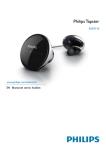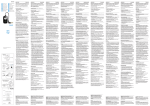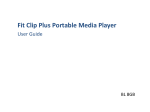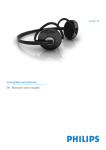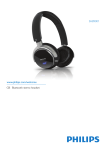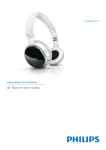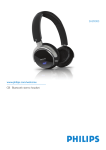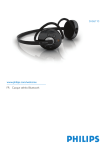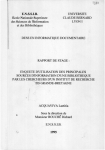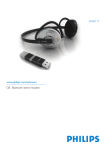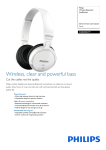Download Philips Tapster SHB7110 Bluetooth stereo headset
Transcript
Philips Tapster SHB7110 www.philips.com/welcome GB Bluetooth stereo headset Table of contents 1 Welcome 3 8 2 2.1 2.2 4 4 8.1 8.2 4 5 5 6 6 6 8.3 2.3 2.4 2.5 2.6 2.7 Important Hearing safety Electric-, Magnetic- and Electromagnetic Fields (“EMF”) General maintenance Disposal of your old product Notes for battery disposal Notes on certification and approbation Trademarks 3 3.1 in the box What else you’ll need 7 7 4 What you can do with your Philips Tapster Bluetooth stereo headset 8 Overview of your Philips Tapster Bluetooth stereo headset 9 5 6 6.1 6.2 6.3 7 7.1 7.2 7.3 7.4 2 Get started 10 Charge your headset 10 Pair your Philips Tapster Bluetooth stereo headset with your mobile phone 11 Fitting your headset 12 Using your touch sensitive Philips Tapster Bluetooth stereo headset Connecting your Philips Tapster Bluetooth stereo headset to your mobile phone Automatic power saving Controlling your touch sensitive Philips Tapster Bluetooth stereo headset Storing and carrying your headset 13 13 13 13 15 Using more of your Philips Tapster Bluetooth stereo headset 16 Learn about the battery status 16 Learn about simultaneous use for voice and audio 16 Learn about FullSound 17 9 Technical data for your Philips Tapster Bluetooth stereo headset 18 10 Frequently asked questions 19 Welcome ENG L ISH 1 With the intuitive simplicity of your Philips Tapster Bluetooth stereo headset with touch and gesture controls nothing gets between you and your music. Let FullSound enhancement amaze you with rich and lively music. EverClear technology minimizes echo and background noise for clear conversations. Angled Acoustics design leads to a snug fit of the headset for optimum comfort and a perfect acoustic seal for a great sound experience. Spend a few minutes to learn more about your headset and you will be ready to fully immerse yourself into your music and calls. Enjoy the Philips Tapster experience! 3 2 Important 2.2 1 2.1 Hearing safety Danger To avoid hearing damage limit the time you use the headphones at high volume and set the volume to a safe level. The louder the volume the shorter is the safe listening time. Be sure to observe the following guidelines when using your headphones. • Listen at reasonable volumes for reasonable periods of time. • Be careful not to adjust the volume continuously upwards as your hearing adapts. • Do not turn up the volume so high that you can’t hear what’s around you. • Excessive sound pressure from earphones and headphones can cause hearing loss. • You should use caution or temporarily discontinue use in potentially hazardous situations. • Using this headset with both ears covered while driving is not recommended and may be illegal in some areas while driving. • For your safety avoid distractions from music or phone calls while in traffic or other potentially dangerous environments. 4 2 3 4 5 Electric-, Magnetic- and Electromagnetic Fields ( EMF ) Philips Electronics manufactures and sells many products targeted at consumers, which, like any electronic apparatus, in general have the ability to emit and receive electromagnetic signals. One of Philips leading Business Principles is to take all necessary health and safety measures for our products, to comply with all applicable legal requirements and to stay well within the EMF standards applicable at the time of producing the products. Philips is committed to develop, produce and market products that cause no adverse health effects. Philips confirms that if its products are handled properly for their intended use, they are safe to use according to scientific evidence available today. Philips plays an active role in the development of international EMF and safety standards, enabling Philips to anticipate further developments in standardization for early integration in its products. General maintenance To avoid damage or malfunction: • Do not expose the headset to excessive heat. • Do not drop your headset. • Apparatus shall not be exposed to dripping or splashing. • Do not allow your headset to be submerged in water. • Do not use any cleaning agents containing alcohol, ammonia, benzene, or abrasives. • The main plug of AC/DC adapter is used as the disconnect device, the disconnect device shall be readily operable. • If cleaning is required use a soft cloth, if necessary dampened with a minimum amount of water or diluted mild soap, to clean the product. About operating and storage temperatures • Do not operate or store in a place where temperature is below -15ºC (5ºF) or above 55ºC (131ºF) as this may shorten your battery life. • The integrated battery shall not be exposed to excessive heat such as sunshine, fire or the like. 2.4 Disposal of your old product ENG L ISH 2.3 Your product is designed and manufactured with high quality materials and components, which can be recycled and reused. When this crossed-out wheeled bin symbol is attached to a product, it means the product is covered by the European Directive 2002/96/EC. Please be informed about the local separate collection system for electrical and electronic products. Please act according to your local rules and do not dispose of your old product with your normal household waste. The correct disposal of your old product will help prevent potential negative consequences to the environment and human health. 5 2.5 Notes for battery disposal If in your country there is no collection / recycling system for electronic products you can protect the environment by removing the battery before disposing the headset.Your product contains a built-in rechargeable battery covered by the European Directive 2006/66/ EC, which cannot be disposed of with normal household waste. Take your product to an official collection point or service centre where a professional can remove the battery. Removing the battery will destroy the product. 2.6 Notes on certification and approbation Hereby, Philips Consumer Lifestyle, BU P&A, declares that this Philips Bluetooth headset SHB7110 is in compliance with the essential requirements and other relevant provisions of Directive 1999/5/EC. Check the root folder of your user manual CD or an addendum sheet for the Declaration of Conformity. 2.7 Trademarks Trademarks are the property of Koninklijke Philips Electronics N.V. or their respective owners. The Bluetooth word mark and logos are owned by the Bluetooth SIG, Inc. and any use of such marks by Koninklijke Philips Electronics N.V. is under license. Tapster, EverClear and FullSound are trademarks belonging to Koninklijke Philips Electronics N.V. 6 What’s in the box: Philips Tapster Bluetooth stereo headset SHB7110 ENG L ISH 3 Carrying Case Exchangeable rubber ear caps Optional earhooks SHB7110 Quick Start Guide 3.1 User manual on CD AC Charger (100-240V) Exchangeable Charging Pins What else you’ll need A mobile phone that is capable of Bluetooth stereo streaming, i.e. that is compatible with the Bluetooth A2DP profile. Other devices (Notebooks, PDA’s, Bluetooth adapters, MP3 players etc.) are also compatible if they share the Bluetooth profiles supported by the headset. These profiles are: For wireless stereo listening: • The Bluetooth Advanced Audio Distribution profile (A2DP). For wireless music control: • The Bluetooth Audio Video Remote Control profile (AVRCP). For wireless handsfree communication: • The Bluetooth headset profile (HSP) or the Bluetooth Handsfree profile (HFP). The Philips Tapster Bluetooth stereo headset features Bluetooth Version 2.1+EDR, but it will also work with devices featuring other Bluetooth versions that support the profiles above. 7 4 What you can do with your Philips Tapster Bluetooth stereo headset With your Philips Tapster Bluetooth stereo headset you can: • Lead wireless hands-free conversations • Wirelessly listen to music • Wirelessly control music • Switch between calls and music 8 Overview of your Philips Tapster Bluetooth stereo headset LED indicator light Exchangeable rubber ear cap On/Off Microphone Left earpiece Right earpiece Touch sensitive area Touch sensitive area Charging socket Left earpiece Right earpiece 9 ENG L ISH 5 6 Get started 6.1 Charge your headset Caution Finish your call before charging the headset, as connecting the headset for charging will cut an ongoing call. During charging you can operate the headset normally. Before you use your headset for the first time, charge the battery for 6 hours for optimum battery capacity and life time. Plug the charger into a wall outlet and connect the charger cable to the headsets charging socket. Warning Use only the original charger or a standard aftermarket micro USB cable for charging. Using another charger may damage or destroy your headset. During recharging the LED indicator will show a red light. The LED will turn off once charging is complete. If you try to charge the headset when it is full the LED will not light up. Your charger comes with two plugs, one for most European countries and another one for the UK. Before you use the charger for the first time please select the correct plug fitting the wall outlets in your country and mount it onto the power adapter until it clicks in place. To remove the plug and exchange it with the other plug, pull the latch on the charger away from the plug and pull the plug out. 10 Typically a full charge will take 2 hours, during this time you can use your headset for calls and music. Tip You can save energy and protect the environment by unplugging the charger after charging is complete. Pair your Philips Tapster Bluetooth stereo headset with your mobile phone Your Philips Tapster Bluetooth stereo headset must be paired to your mobile phone before connecting and using it for the first time with your phone. “Pairing” will establish a unique encrypted link between your mobile phone and your headset. Pairing has to be done only once, before using your headset with your mobile phone or another Bluetooth device for the very first time. • Only if you pair more than two different Bluetooth devices with your headset, you may need to pair the previously paired devices again.Your headset can store up to two paired devices in its memory, if you pair more than two devices the oldest paired device is overwritten. • “Pairing” is different from “connecting” as pairing typically only has to be done once, whereas the phone and headset need to “connect” every time one of the two devices was turned off or out of range. With typical phone settings your Philips Tapster Bluetooth stereo headset will connect automatically to your phone after you turned on the headset. To pair your headset with your mobile phone 1 Make sure your headset is charged and turned Off. 2 Make sure your mobile phone is on and its Bluetooth feature is enabled. 3 Press On/Off B on the right earpiece until the LED starts blinking red and blue alternately. The headset will now remain in “pairing mode” for 5 minutes. LED 4 Check your phone’s user manual for specific details. • • • on/off charging socket Pair the headset with your mobile phone as described below. A sample pairing is shown below. Access the Bluetooth menu on your mobile phone typically called “Setup”, “Settings”, “Bluetooth” or “Connectivity”. Select the option to discover, add or search for a Bluetooth device. After a few seconds your phone should indicate that it has found the “Philips SHB7110”. Upon selecting the “Philips SHB7110” on your mobile phone typically you will need to confirm the pairing and enter a passcode. 11 ENG L ISH 6.2 Please enter the headsets passcode “0000” (four zeros). After successful pairing, the headset will connect to the mobile phone.You will hear a long beep to confirm successful pairing and the headsets LED will change from flashing red/blue to periodically flashing blue every three seconds. 6.3 1 Optional: For an extra-secure sports fit, attach the earhook. B A Fitting your headset Select your cap size for the best find and optimum sound performance. It is not unusual to fit two different exchangeable rubber ear cap sizes on the right and left earpiece. L M S 2 Place the exchangeable rubber ear cap in your ear and rotate the headset backward for a snug fit. 3 Bring the connecting wire to the back of the neck and insert the second earpiece. 12 4 A. Insert the ball between the earpiece and the earshell until it rests in the socket which is located between the earpiece and the earshell. B. Rotate the hook to fit your ear. C. Slide the hook over your ear. D. Follow steps 2 and 3 as above. Using your touch sensitive Philips Tapster Bluetooth stereo headset 7.1 Connect your Philips Tapster Bluetooth stereo headset to your mobile phone Tip To avoid accidental activation of music or calls the touch sensitive areas of the headset are only enabled after you inserted the headset in your ears.You will hear an ascending activation and descending de-activation tone when inserting or removing your Philips Tapster Bluetooth stereo headset. The whole outer shell of the earpieces is touch sensitive. Touch sensitive surface Turn on the headset by pressing On/Off B until the LED lights up. Once turned on the headset will reconnect automatically to the last device it was connected to. If the last connected device is not available the headset tries to reconnect to the second to last device that was connected to the headset. If you turn the mobile phone or its Bluetooth feature on after turning on the headset connect the headset from your mobile phones Bluetooth menu. 7.2 Automatic power saving If your headset cannot find any Bluetooth device to connect to in range within five minutes it will automatically power down to save battery life. 7.3 Controlling your touch sensitive Philips Tapster Bluetooth stereo headset You can control all functions of the headset with these basic motions. Tap Tap the surface Double tap Tap the surface twice quickly Press Press and hold for approximately 1 second Slide Slide your finger forward or backward across the surface of the earpiece Your Philips Tapster Bluetooth stereo headset uses intuitive touch controls so you can easily control your music and calls. After a few minutes of familiarizing yourself with the new touch controls you should find this way of controlling the headset faster and simpler than button based headsets. 13 ENG L ISH 7 The table below shows how to control your music and calls with these basic motions. Tip You will find that all of the call functions are located on the right earpiece so you can use the headset for calls even if the left earpiece is not in your ear. Left Right Power N/A Power On / off Music Next song / previous song Stop Slide forward / backward Press (hold 1/2 sec) Music Volume up / down Play / pause Press B Slide forward / backward Tap FullSound (natural / Double tap while music is dynamic bass) playing Calls N/A Calls Volume up / down Slide forward / backward Tap Answer call Hang up / reject call Redial last no. Press (hold 1/2 sec) Activate voice dial Press (hold 1/2 sec) Transfer call to phone / headset Mute mic Remove / insert earpiece Double tap Double tap during call Pick up an inTap coming call and put the current active call on hold. Reject an incoming Press (hold 1/2 sec) call and continue the current active call. 14 Storing and carrying your headset ENG L ISH 7.4 Your headset comes with a protective carrying case for the headset and the optional earhooks. Wind the cable that connects the two earpieces in the cable groove to neatly store the headset. 15 8 Using more of your Philips Tapster Bluetooth stereo headset 8.1 Learn about simultaneous use for voice and audio Your Bluetooth stereo headset can connect to one Bluetooth audio source (supporting the A2DP and AVRCP Bluetooth profile) and one Bluetooth communication source (supporting HFP or HSP Bluetooth profile) at the same time. Learn about the battery status Immediately after turning the headset on, the LED will indicate the battery status. LED behaviour Battery status 3x red blinking Less than 25% of charge remaining 2x red blinking Less than 50% of charge remaining 1x blue blinking 50% or more of charge remaining Approximately five minutes before the battery runs out you will hear two short beeps every minute to remind you to end the call or transfer it to your phone before the battery runs out. The LED will also continuously flash red with about five minutes of talk time remaining. 16 8.2 Therefore you can connect your Bluetooth stereo headset • with a Bluetooth stereo enabled phone to both listen to music and lead calls, or • with a Bluetooth phone that only supports Bluetooth communication (i.e. does not support Bluetooth stereo (A2DP)) to lead calls and at the same time to a Bluetooth stereo device (Bluetooth enabled MP3 player, Bluetooth audio adapter etc.) to listen to music. Make sure to pair the phone first with your Bluetooth headset, then turn both the phone and headset off to then pair the Bluetooth audio device. With the SwitchStream feature you can listen to music and monitor your calls at the same time. While listening to music, you will hear a ring tone when receiving a call and can switch to the call simply by tapping the earpiece. Learn about FullSound ENG L ISH 8.3 FullSound is a smart digital sound enhancement algorithm, which runs on a powerful processor inside your Bluetooth headset. It restores and enhances bass, treble, stereo effects and dynamics of compressed music and leads to a more natural, “real life” sound experience based on years of acoustic research and tuning. There are two FullSound settings on your Philips Tapster Bluetooth stereo headset: • The “Natural” FullSound setting is optimized for the most natural, audiophile reproduction of music, ideal for classical, acoustic, Jazz and voice dominated music. • The “Dynamic Bass” setting emphasizes deep frequencies for a more powerful bass ideal for Hip Hop, Techno and other bass driven music styles, or for extra motivation during your workout. When you buy the product the “Natural” FullSound setting is enabled. To switch between the two settings double tap the left earshell two times. The “Natural” FullSound setting is confirmed by an ascending tone, the “Dynamic Bass” FullSound setting is confirmed by a descending tone. 17 9 Technical data for your Philips Tapster Bluetooth stereo headset • Intuitive touch and gesture sensitive controls • FullSound digital sound enhancement for rich, lively music • EverClear echo and noise reduction for clear calls • Angled acoustics ergonomic design • Up to 6 hours of music playback time • Up to 7 hours of talk time • Up to 150 hours of standby time • Typical time for a full charge: 2 hours • Rechargeable Lithium-Polymer battery (160mAh) • Bluetooth 2.1+EDR, Bluetooth stereo support (A2DP – Advanced Audio Distribution Profile, AVRCP – Audio Video Remote Control Profile), Bluetooth mono support (HSP – Headset Profile, HFP HandsFree Profile) • Operating range up to 10 meters (33 feet) • Frequency Range: 20 Hz to 20 KHz Specifications are subject to change without notice. 18 Frequently asked questions Bluetooth headset does not switch on. Battery is very low. Charge your Bluetooth headset. Mobile phone cannot find headset. • The headset may be connected to another previously paired device. Turn the currently connected device off or move it out of range. • Pairings may have been reset or headset has been previously paired with other device. Start the pairing process as described in this user manual. No connection to mobile phone. Bluetooth disabled. Enable Bluetooth on your mobile phone and turn the headset on after turning on the phone. Voice dialing or redialing does not work. Your mobile phone may not support this feature. Headset falls out of ear / does not fit properly. Chosen exchangeable rubber ear cap not fitting. Fit the correct exchangeable rubber ear cap size for each ear and check previous pages for the “insert & twist” fitting motion. Try the earhook for extra-stable fit. Why does my phones AM/FM radio not work when using my Bluetooth headset. No AM/FM antenna available. Most mobile phones require a corded headset, which they use as an antenna, for FM radio capability. If your phone supports Internet radio this feature will work with your Bluetooth headset. Touch controls are not working. Out-of-ear autolock engaged. Touch & gesture controls will only work after the headset is inserted into your ear. Check for the ascending activation sound when inserting each exchangeable rubber ear cap. Try to reinsert your exchangeable rubber ear cap if you did not hear the activation sound. The headset is connected to a Bluetooth stereo (A2DP profile) enabled phone, but music will play on the phone’s speaker only. Phone may have option to listen to music via speaker or headset. Check your phones user guide on how to transfer the music to the headset. Touch controls are too sensitive / not sensitive enough. Familiarity with touch controls. For the first few minutes you may find the headsets touch controls too sensitive or not sensitive enough. The sensitivity of the touch controls has been set to suit a range of customers. It may require a few minutes of “training” with your headset to get used to the new controls. Audio quality when streaming from phone is very low or audio streaming does not work at all. Phone may not be Bluetooth Stereo (A2DP profile) compatible and only support Bluetooth mono (HSP/HFP profile). Check your phones compatibility. 19 ENG L ISH 10 Audio quality is poor and crackling noises can be heard. Bluetooth audio source is out of range. Reduce the distance between the headset and the Bluetooth audio source, or remove obstacles between them. I hear but cannot control the music on my device (e.g. skip forward / backward). The music device does not support this feature (AVRCP profile). Check the user manual of your audio source. Please visit www.philips.com/support for additional support. 20 2009 © Koninklijke Philips Electronics N.V. All rights reserved.





















